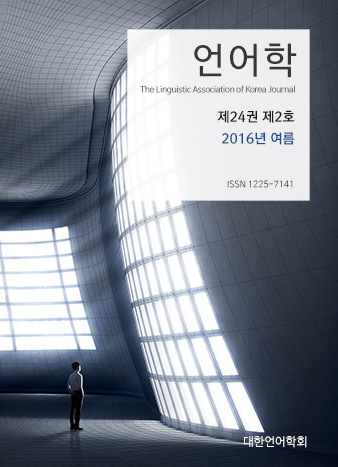대한언어학회 전자저널

-
A Corpus-based Study on the Use of English Present Perfect by Chinese EFL Learners
-
A Study of Curricular Components of English/Korean-Language Textbooks
-
The Effects of Listening Encoding Strategy Use on Korean EFL Learners’ EAP Listening Comprehension
-
A Study on the Correlation between Self-Efficacy Beliefs and Strategies in English Reading
Abstract
Keywords
# 보편문법(Universal Grammar) # 핵매개변인(head-parameter) # 핵어선(head-initial) # 핵어말(head-final) # Spec-head-complement(지정어-핵-보어)
References
- 이정식. (2012). 자유어순변이, 선형화 및 강력최소주의. 언어학, 20(2), 81-104.
- 이정훈. (2011). 후보충 구문의 구조와 Ω 그리고 빈칸. 현대문법연구, 64, 95-116.
- Berwick, R., & Chomsky, N. (2008). The biolinguistic program: The current state of its evolution and development. Ms., MIT.
- Boeckx, C. (2008). Approaching parameters from below. Ms., Harvard University.
- Borer, H. (1984). Parametric syntax: Case studies in Semitic and Romance languages. Dordrecht: Foris.
- Chomsky, N. (1981). Lectures on government and binding. Dordrecht: Foris.
- Chomsky, N. (1994). Bare phrase structure. MIT Working Papers in Linguistics, No. 5. MIT, Cambridge, MA.
- Chomsky, N. (2001). Derivation by phase. In M. Kenstowicz (Ed.), Ken Hale: A life in language (pp. 1-52). Cambridge, Mass: MIT Press.
- Chomsky, N. (2005). Three factors in language design. Linguistic Inquiry, 36, 1-22.
- Chomsky, N. (2006). Approaching UG from below. Ms., MIT.
- Chung, D. (2009). An elliptical coordination analysis of the right dislocated construction in Korean. The Linguistic Association of Korea Journal, 17(4), 1-23.
- Chung, D. (2010). Replies to Lee (2009): In defence of a double clause approach to the right dislocated construction. Studies in Modern Grammar, 61, 167-196.
- Epstein, S., Groat, D., Kawashima, R., & Kitahara, H. (1998). A derivational approach to syntactic relations. New York: Oxford University Press.
- Greenberg, J. (1963). Some universals of grammar with particular reference to the order of meaningful elements. In Joseph Greenberg (Ed.), Universals of language, 73-113. Cambridge, MA: MIT Press.
- Hornstein, N. (2009). A theory of syntax: Minimal operations and universal grammar. Cambridge: Cambridge University Press.
- Fukui, N. 1993. Parameters and optionality. Linguistic Inquiry, 24, 399-420.
- Fukui, N., & Takano, Y. (1998). Symmetry in syntax: Merge and Demerge. Journal of East Asian Linguistics, 7, 27-86.
- Kang, M.-Y. (1988). Topics in Korean syntax: phrase structure, variable binding and movement. Unpublished doctoral dissertation. MIT. Cambridge, MA.
- Kayne, R. (1994). The antisymmetry of syntax. Cambridge, Mass.: MIT Press.
- Koopman, H. (1983). The syntax of verbs. Dordrecht: Foris Publications.
- Lee, J.-S. (2007). Deriving SOV from SVO in Korean. The Linguistic Association of Korea Journal, 15(3), 1-20.
- Lee, J.-S. (2008). Notes on right dislocated constructions in Korean. The Linguistic Association of Korea Journal, 16(2), 47-68.
- Lee, J.-S. (2009). A verb-initial single clause analysis to right-dislocated constructions in Korean. Studies in Modern Grammar, 57, 127-157.
- Lee, J.-S. (2011a). Layered VP and inner aspect. Studies in Modern Grammar, 65, 45-72.
- Lee, J.-S. (2011b). Some loopholes of the double clause approach to the right dislocation construction in Korean. Studies in Modern Grammar, 63, 113-146.
- Longobardi, G. (1994). Reference and propser names: a theory of N-movement in syntax and Logical Form. Linguistic Inquiry, 25, 609-665.
- Richards, M. (2008). Two kinds of variation in a minimalist system. In F. Heck, G. Müller & J. Trommer (Eds.), Varieties of competition. Linguistishce Arbeits Berichte, 87 (pp.133-162). Universität Leibzig.
- Roberts, I. (2000). The fine structure of the C-system in some Celtic languages. Ms., Cambridge University.
- Saito, M. (2013). Case checking/valuation in Japanese: Move, Agree or Merge. Nanzan University Research Report in 2008-2012, 203-221.